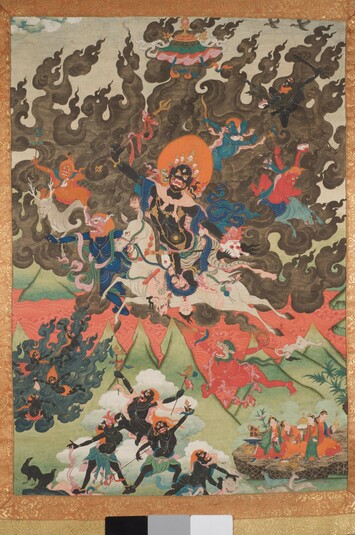
Item: Shri Devi (Buddhist Protector) - Magzor Gyalmo
| Origin Location | Tibet |
|---|---|
| Date Range | 1800 - 1899 |
| Lineages | Gelug and Buddhist |
| Material | Ground Mineral Pigment on Cotton |
| Collection | Private |
Shri Devi, Magzor Gyalmo (Tibetan: pal den lha mo, mag gyi zor le, gyal mo. English: Glorious Goddess, the Queen who Repels Armies, or the Queen who has the power to turn back armies. Sanskrit: Shri Devi, Yakshi Remati): belonging to the larger class of enlightened protector deities known as Shri Devi. Magzor Gyalmo is regarded as a wrathful emanation of the peaceful goddess Sarasvati, popular in both Hinduism and Buddhism.

"... Shri Devi Remati, Queen of the Army Repelling Weapons, riding a mule, blue-black in colour, with one face and two hands, having bared fangs and gnashing down on a human corpse. Possessing three round red eyes, and the forehead furrowed into a frown, brown hair flowing upwards with licks of flame and smoke issuing forth. The right ear is adorned with a poisonous snake and the left with a lion, crowned with five dry human skulls and a necklace of fifty blood dripping wet [heads] strung with intestines. ... having a lower garment of tiger skin, a snake belt and necklace, etc. The right hand holds to the sky a sandalwood stick marked with a vajra. The left holds to the heart a mustard seed and blood filled skullcup. ... At the level of the navel is a sun and at the crown of the head a crescent moon; above the head is a peacock parasol canopy." (Sharchen Champa Kunga Tashi 1558-1603, TBRC P778. Drub Tab Kun Tu vol.9, pp.606-607. TBRC W19221).
The textual source for Magzor Gyalmo is the Dakinyagnijihajvala Tantra, Dege Kanjur, volume 98, pp.223-253. It is found in the Nyingma Tantra section, vol.3. TBRC w22084.
This painting is likely the work of the same artist who painted the Dragpa Gyaltsen composition, now at the Rubin Museum of Art and the Tanma Chunyi in the Guimet Museum, Paris. The style of the Shri Devi painting is also related to another Naropa composition in the RMA, the Ford Mahasiddha set, a seven painting Dalai Lama set and a thirteen painting set of the Eighty-four Mahasiddhas according to the system of Vajrasana. (A Mongolian copy of this mahasiddha set can be found in Ganden Monastery, Ulan Bator). All of these Tibetan works are dated to the early 1800s.
Jeff Watt 7-2009
Artist: Khazi Lhazo Style (Shri Devi)
Artist: Khazi Lhazo Subjects List
Buddhist Protector: Shri Devi, Magzor Gyalmo Main Page
Artist: Khazi Lhazo Page
Buddhist Protector: Shri Devi, Magzor Gyalmo (Rubin Museum)
Buddhist Protector: Shri Devi, Magzorma (Masterworks)
Buddhist Protector: Shri Devi, Magzor Gyalmo Art History









